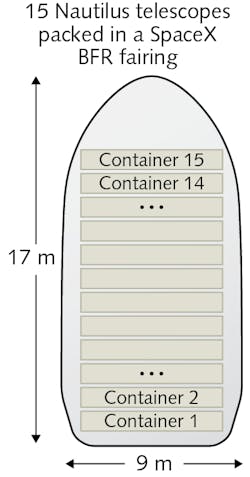Multi-order diffractive optical elements could lead to extremely light space telescopes

Researchers from the University of Arizona (UA; Tucson, AZ) and Northrop Grumman Aerospace Systems (Redondo Beach, CA) are developing a new approach to very large lightweight telescope mirrors that could greatly increase the power of space telescopes while reducing their fabrication and launch costs. The concept is based on multi-order diffractive optical elements (MODE lenses) that are 10X lighter per area and 100X less sensitive to misalignments that conventional lightweight large telescope mirrors cause. A MODE lens consists of a multiple-order diffractive element combined with a weak diffractive Fresnel lens, which compensates a small amount of chromatic aberration arising from the multiple-order diffractive element. The MODE lens can be made quickly and cheaply using a molding process.
UA associate professor Daniel Apai, of the UA’s Steward Observatory and the Lunar and Planetary Laboratory, leads the space science half of the team, while UA professor Tom Milster, of the James C. Wyant College of Optical Sciences, leads the optical design of a replicable space telescope dubbed Nautilus. The researchers intend to deploy a fleet of 35 14-m-wide spherical balloon-shaped telescopes, each individually more powerful than the Hubble Space Telescope, and, combined, having an aperture area equivalent to a 50 m diameter aperture (conceptually, 15 folded Nautilus telescopes can fit in a SpaceX Big Falcon Rocket fairing). Each unit will contain an 8.5-m-diameter MODE lens, which will be used for astronomical observations. One use particularly exciting for Apai is the spectroscopic analysis of starlight as it filters through planetary atmospheres, a technique that could reveal chemical signatures of life. When combined, the telescope array will be powerful enough to characterize 1000 extrasolar planets from as far away as 1000 light years. The project has received $1.1 million from the Moore Foundation to create a prototype of a single telescope and test it on the 61 in. Kuiper Telescope on Mt. Bigelow by December 2020. Reference: D. Apai et al., Astron. J. (2019); https://doi.org/10.3847/1538-3881/ab2631.
About the Author
John Wallace
Senior Technical Editor (1998-2022)
John Wallace was with Laser Focus World for nearly 25 years, retiring in late June 2022. He obtained a bachelor's degree in mechanical engineering and physics at Rutgers University and a master's in optical engineering at the University of Rochester. Before becoming an editor, John worked as an engineer at RCA, Exxon, Eastman Kodak, and GCA Corporation.
